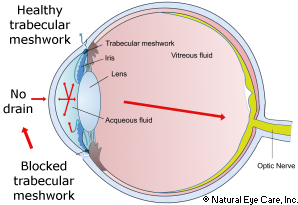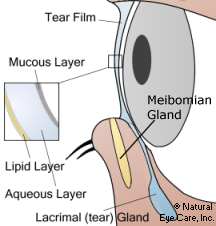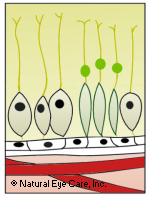CVS - Computer Eye Strain
Vitamins/supplements Symptoms & Causes Glaucoma warning Laptops Desktops For parents News
Computer eye strain is the #1 eyestrain complaint in the U.S.

CVS (computer vision syndrome), more commonly known as computer eye strain is a combination of vision problems noticed during and after working long hours on the computer. OSHA describes it as a repetitive strain disorder affecting 90% of U.S. workers on computers daily.
Computers are becoming ubiquitous - they are everywhere and in many forms - all requiring close focused vision.
 Next: Nutritional support, diet, & lifestyle tips for computer eye fatigue.
Next: Nutritional support, diet, & lifestyle tips for computer eye fatigue.
In the case of students on computers and computer professionals, the HEV light emitted by computers is another serious source of light that can damage the retina and cause macular degeneration.1, 2
Consequences of Computer Eyestrain
Computer eyestrain is a contributing cause to a host of eye conditions including glaucoma, dry eye, advanced macular degeneration, damage to rods and cones, damage to the retinal pigmented layer of macula, and eye cancer.
In one study with university students regarding computer use and eye problems, many exhibited eye issues including the following: headache (53.3%), burning sensation in the eyes (54.8%) and tired eyes (48%). While studies on the effects of computer eyestrain are not yet prevalent, taking a look at data related to repetitive strain injuries (RSIs) can help put this problem into perspective.

Glaucoma
Researchers found, in a 2004 study of more than 9,000 computer-based employees in Japan, that many of them were experiencing peripheral vision problems, and a third of those patients had visual field abnormalities (VFA), such as glaucoma. The incidence of glaucoma was higher when the workers also were nearsighted.3 A 2017 study followed more than 2,000 workers (from the 2004 study group) who originally had no VFA for an additional seven years. There was a significant increased risk of VFA among this group.4

Dry Eye Syndrome
The innermost layer of the surface of the eye is an aqueous mucous layer that forms the bulk of the tears, and contains electrolytes, a variety of proteins, and water. This layer is vital to a stable ocular surface, since it allows the tear film to actually adhere to the eye.5 Workers spending the most time on the computer have the lowest concentrations of an essential component of the mucous layer of the tear film, mucin 5AC, which contributes to their dry eye syndrome.6, 7
Photoreceptor Damage

The shortest wavelengths of light (UV and blue light), directly cause damage to the macula, retina, and photoreceptors. The retina contains cells that are impacted by blue light in both the photoreceptors and the retinal pigment epithelium layer (RPE). Photoreceptors contain photo-pigmented cells that change and trigger other functions when they are struck by a photon of light. In the RPE, pigmented cells absorb light and perform a number of functions. Both types of cells are vulnerable to blue light damage.8
Over time, too much computer use has negative effects that add up including development of farsightedness (presbyopia), nearsightedness (myopia), astigmatism, poor eye-coordination, and ability-to-focus disorders. In addition, sitting in the same position for hours causes neck, back and shoulder stiffness and tension headaches, which in turn cause TMJ (temporomandibular joint) pain. And, of course, the threat of direct damage to the retina from HEV blue light.
Causes
We experience computer eye strain because we may be: too close to computer, spending too many hours at the computer, blinking less, have poor posture, have poor lighting, or work with excessive glare.
There are two main issues that cause computer eye fatigue and contribute to potentially serious vision problems, eye movement and distance, and blue light.
Eye Movement and Distance
Our daily activities form a tremendous shift from how our parents and grandparents lived. Since humans evolved as hunters and gatherers, our vision was designed for distance. Yes, there was some close-up work; but most of the time our ancestors needed to gaze afar to decide where they could most easily access food and water and to keep themselves safe from potential predators. Our eye muscles are most relaxed when we are using our distance vision. In the absence of mostly close-up work, our grandparents' eyes flexed continually during the day, from near to far, from far to near. Vision problems arose when long hours of close work in poor light brought eyestrain.
Furthermore, we are also designed to move. Sitting all day in one position is unnatural and has consequences for both vision and general health. Studies show that digital device users blink about half as frequently, and the surface of their eyes gets drier.
Staring at your computer for long hours without a break strains your eyes and bodies and results in computer eye strain. Studies show that computer users blink less often, which, Japanese researchers indicate, greatly increases one's risk of developing short-term dry eye syndrome.
Blue Light
While patients may be familiar with vision damage from UVA and UVB light from the sun, few are aware of the damage to the retina from blue light, or HEV light, which is emitted by digital screens, electronic devices, fluorescent energy-saving light bulbs, and LED lighting. The sun also emits blue light, so we are at risk for exposure while outdoors as well.
Because blue light is a short wavelength, it has more energy and “flickers” more easily than longer, weaker wavelengths. While not superficially noticeable, blue light creates glare, reduces visual contrast, affects vision acuity, and causes general eyestrain, headaches, and fatigue. The damaging effects of blue light are more serious in low light conditions when the pupil is enlarged and takes in more light. Consequently, the retina receives a larger dose of blue light.
Note. In natural light, blue light is combined with other spectrums of light that helps us maintain our circadian-rhythm. Artificial light at night can confuse out brains into thinking it is still daytime, affecting our ability to sleep well. The lack of blue light at night stimulates the pineal gland that produces adequate amounts of melatonin, which helps us sleep.
Other Blue Light Vision Damage
Blue Light Damages Rods and Cones
Recent research using mice helps explain just how and why the eye is damaged by blue light. Mice that were exposed to high levels of blue light displayed the following characteristics:
- Massive irreversible cell death that was identified as shrinkage of protein, DNA, and RNA from both the inner and outer layers of photoreceptor rods and cones.9
- Leaking and rupture of fine capillaries in retina cone photoreceptors.
- Edema or swelling of the retina.
- Development of cystoid spaces (cysts) further indicating edema.
- Changes in expression of certain proteins.
- Inner blood-retinal barrier damaged.
In humans, this translates to widespread leaking and rupture of tiny blood vessels in the photoreceptor level of the macula, in turn, damaging the remainder of the macula. This may be expressed in a number of vision conditions, such as macular degeneration, choroid neovascularization, macular edema, retinitis pigmentosa, macular pucker, Stargardt’s, cone-rod dystrophy, and diabetic retinopathy.
Rod Cell Protein
There’s a light-sensitive protein called rhodopsin that is found in photoreceptor rod cells that supports vision in dim light. Rhodopsin levels are low in bright light and high in dim light. This protein triggers retinal damage by blue light during dim lighting conditions.10 Furthermore, rods are more sensitive to blue light than cones, exacerbating the problem.11 This is the reason that it is important to not use computers or smartphones emitting blue light during dim light conditions.
Retinal Pigment Epithelium (RPE)
Retinal pigment epithelium is a single-cell layer within the retina that provides nourishment to the photoreceptor cells and protects the division between the retina and the rest of the eye. It contains pigmented granules that absorb scattered light; it secretes a number of signaling photochemicals; it forms an immune-safe barrier between the photoreceptors and blood vessels; and it is an essential part of the vision process. Blue light harms the RPE, but just how is somewhat obscure. It is clear that such damage does occur, and that filtering, as with amber glasses, prevents such damage.12
Eye Cancer
Blue light is associated with significantly increased rates of cell division (mitosis), implicating it in uveal cancers. In some animal models, blue light was found to markedly increase the rate of cancer cell proliferation. In other animal studies where no uvea melanomas previously existed, exposure to blue light contributes to development of such cancers. Blue light stimulates the development of DNA lesions, especially in the presence of free radicals.13
Biochemical Change
A study published in 2018 found that blue light changes and damages a signaling biochemical, phosphatidylinositol 4,5 bisphosphate (PIP2), causing cell death; alpha-tocopherol reduces the change.14
Insomnia
The pineal gland secretes the hormone melatonin; this is the body’s biochemical signal of biological darkness, in other words, the signal that you are ready for sleep. Blue light suppresses production of melatonin15 to a surprisingly profound degree.16 If you are exposed to blue light right before bedtime (e.g. checking your email one more time), it throws off the internal rhythm that allows you to get adequate sleep. Nearly 75% of children now use some sort of electronic device in their bedroom. The use of these devices markedly impacts sleep quality, which in turn, contributes to social adjustment problems, behavioral problems in school and at home, and surprisingly, weight gain.
While most research on the effects of smartphones on sleep and circadian rhythms have involved children and teens, adults are also adversely impacted. One Flemish study included more than 800 adults, 50% of whom owned smartphones, and 60% of whom used their smartphone during the night. Nighttime phone use and texting at night markedly increased how long it took to fall asleep and markedly decreased the quality, duration, and efficiency of sleep.
- In younger adults, nighttime electronic-device use was tied to more fatigue and later rising time.
- In older adults, it was associated with shorter sleep duration and earlier rise time.17
Damage to Macula
Ongoing exposure to blue light increases the risk of neovascular (wet) macular degeneration, particularly associated with low levels of antioxidants, and especially low levels of vitamin C, zeaxanthin, and vitamin E.18 Another study suggested that extended exposure to sunlight outdoors may be associated with age-related maculopathy.19
 To learn more about damage due to blue and UV light, and how you can protect your vision through diet, lifestyle, and nutrition, read our newly updated complete guide: Natural Eye Care: Your Guide to Healthy Vision and Healing, also available as an e-book, or our
mini-book on cataracts.
To learn more about damage due to blue and UV light, and how you can protect your vision through diet, lifestyle, and nutrition, read our newly updated complete guide: Natural Eye Care: Your Guide to Healthy Vision and Healing, also available as an e-book, or our
mini-book on cataracts.
Symptoms
- Eyestrain and fatigue
- Blurred or fuzzy vision
- Dizziness, upset stomach
- Difficulty focusing on work
- Headaches and migraine headaches
- Dry, red, or irritated eyes
- Increased myopia (nearsightedness)
- Color vision changes
- Slow ability to refocus
- Excessive tiredness
- Neck strain, shoulder, and upper and lower back pain
- Occasional double vision, or eye-coordination problems
Eye Fatigue
When our eyes get tired two things happen:
Eye movement: the saccade

Our eyes engage in incredibly rapid constant motion - hundreds of thousands of movements daily, jumping around to parts of the scene before us that command our interest. The information taken in through this continual scanning movement, known as saccade, or micro-saccade, is communicated to the brain and we are able to perceive what is before us without looking at every detail. The continual saccade is both involuntary and efficient as the eyes travel from bit of information to bit of information forming an understanding of the whole.
The function of the saccade is to continually refresh the information sent to the brain. Each saccade causes the image you see to shift to a different part of the retina. This in turn causes the image to adapts to a new neuron in your eye and brain, and in turn, to be interpreted afresh. So these micro-saccades keep everything visible for you.
Blink rate & eye moisture
The tear film and the blinking process also make vision possible.
Tear film is the moisture-laden surface of the eye2, consisting of three layers (mucus layer, aqueous layer & lipid layer). These interrelated layers work together to remove debris from the surface of the eye, and to lubricate and protect the surface of the eye. Blinking, normally about 10-12 times a minute, is a natural function that helps maintain this tear film.
Blinking momentarily disrupts the saccade. However, when we are intensely focused on one subject, whether while focusing on a computer screen or a watching a deer in the distance, then in order to maintain focus, blinking slows to an average of 3-4 times a minute and the information-gathering saccade is not interrupted.
A slower rate of blinking and/or incomplete blinking means that the tear film is not distributed across the surface of the eye and we experience irritation and fatigue. The tear film begins to become unstable and thin after only 10 seconds without complete blinking.
Muscles of the eye
In order to perform close work several sets of muscles in the eye are active.
- Extraocular muscles cause the eyes to converge to a specific location.
- Ciliary muscles flex the fibrous strands known as the zonules of Zinn which in turn fine-tune the shape of the lens through which light passes on its way to the retina.
- Pupillary muscles which control the diameter of the pupil constrict so that light rays hit only the center of the retina
Just as overuse of our shoulder muscles results in shoulder soreness - short term (acute) and long-lasting (chronic) - overuse of our eyes result in eye fatigue which manifests as asthenopia, computer eye strain, light sensitivity, dry eyes, and other conditions.
When you look at your computer screen for a long time the ciliary muscles remain contracted and eventually get tired and lose their ability to remain contracted. As they loosen the pull on the zonules of Zinn decreases and focus becomes blurry, pain sets in and headaches and other symptoms result.
Furthermore if we wear glasses or contacts then our focus is locked into a specific range. Our eye muscles, not needing to shift for clearer focus, lose their muscle tone and flexibility and their ability to focus accurately.
Related Conditions
- dry eyes
- heavy computer use is a risk factor for glaucoma
- ocular migraine
- migraine headaches
- sensitivity to glare
- myopia
- asthenopia (eye fatigue)
Computer Eye Strain News
Want to learn more? See our blog news on eye strain.
 Find Vitamins & Supplements
to Help Eye Fatigue
Find Vitamins & Supplements
to Help Eye Fatigue
Footnotes
See computer eye syndrome research.
1. The Chesapeake Bay Waterman Study, Transactions of the American Ophthalmological Society. 1989; 87: 802-853
2. Fifteen-year cumulative incidence of age-related macular degeneration: the Beaver Dam Eye Study, R. Klein, et al, Ophthalmology. 2007 Feb;114(2):253-62; this study continued to 2010.
3. Tatemichi M, Nakano T, Tanaka K, Hayashi, T., Nawa, T. et al. (2004). Possible association between heavy computer users and glaucomatous visual field abnormalities: a cross sectional study in Japanese workers. J Epidemiol Community Health, Dec;58(12):1021-7.
4. Nakano, T., Hayaski, T., Nakagawa, T., Honda, T., Owada, S., et al. (2017). Increased Incidence of Visual Field Abnormalities as Determined by Frequency Doubling Technology Perimetry in High Computer Users Among Japanese Workers: A Retrospective Cohort Study. J Epidemiol, Nov 25.
5. JAMA Ophthalmol. 2014;132(8):985-992. doi:10.1001/jamaophthalmol.2014.1008
6. Uchino, Y., Uchino, M., Yokoi, N. (2014). Alteration of Tear Mucin 5AC in Office Workers Using Visual Display Terminals: The Osaka Study. JAMA Ophthalmol, 132(8):985-992.
7. Gipson, I.K., Hori, Y., Argueso, P. (2004). Character of ocular surface mucins and their alteration in dry eye disease. Ocul Surf, 2(2):131-148.
8. Hunter, J.J., Morgan, J.I., Merigan, W.H., Sliney, D.H., Sparrow, J.R., et al. (2012). The susceptibility of the retina to photochemical damage from visible light. Prog Ret Eye Res, Jan;31(1):28-42.
9. Geiger, P., Barben, M., Grimm, C., Samardzija, M. (2015). Blue light-induced retinal lesions, intraretinal vascular leakage and edema formation in the all-cone mouse retina. Cell Death Dis, Nov 19;6:e1985.
10. Grimm, C., Wenzel, A., Williams, T., Rol, P., Hafezi, F., et al. (2001). Rhodopsin-mediated blue-light damage to the rat retina: effect of photoreversal of bleaching. Invest Ophthalmol Vis Sci, Feb;42(2):497-505.
11. Anstis, S., Macleod, D. (2015). Why hearts flutter: Distorted dim motions. J Vis, 15(3): 23.
12. Narimatsu, Tl, Negishi, K., Miyake, S., Hirasawa, M., Osada, H., et al. (2015). Blue light-induced inflammatory marker expression in the retinal pigment epithelium-choroid of mice and the protective effect of a yellow intraocular lens material in vivo. Exp Eye Res, Mar;132:48-51.
13. Logan, P., Bernabeu, M., Ferreira, A., Burner, M.N. (2015). Evidence for the Role of Blue Light in the Development of Uveal Melanoma. J Ophthalmol, 2015:386986.
14. Ratnayake, K., Payton, J.L., Lakmal, O.H., Karunarathne, A. (2018). Blue light excited retinal intercepts cellular signaling. Sci Rep, Jul 5;8:10207
15. Gooley, J.J., Chamberlain, K., Smith, K.A., Khalsa, S.B., Rajaratnam, S.M., et al. (2011). Exposure to Room Light before Bedtime Suppresses Melatonin Onset and Shortens Melatonin Duration in Humans. J Clin Endocrinol Metab, Mar;96(3):E463-72.
16. Vartanian, G.V., Li, B.Y., Chervenak, A.P., Walch, O.J., Pack, W., et al. (2015). Melatonin Suppression by Light in Humans Is More Sensitive Than Previously Reported. J Biol Rhythms, Aug;30(4):351-4
17. Exelmans, L., Van den Bulck, J. (2016). Bedtime mobile phone use and sleep in adults. Soc Sci Med, Jan;148:93-101.
18. Fletcher, A.E., Bentham, G.C., Agnew, M., Young, I.S., Augood, C., et al. (2008). Sunlight exposure, antioxidants, and age-related macular degeneration. Arch Ophthalmol, Oct;126(10):1396-403.
19. Cruickshanks, K.J., Klein, R., Klein, B.E. (1993). Sunlight and age-related macular degeneration. The Beaver Dam Eye Study. Arch Ophthalmol, 111(4):514-518.
Vitamins/supplements Symptoms & Causes Glaucoma warning Laptops Desktops For parents News
 info@naturaleyecare.com
info@naturaleyecare.com



 Home
Home


 Vision
Vision Vision
Vision



 Health
Health Health
Health Research/Services
Research/Services Pets
Pets About/Contact
About/Contact


